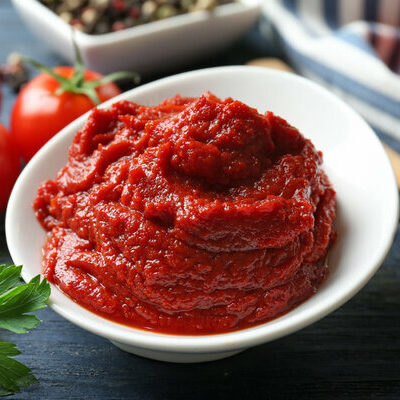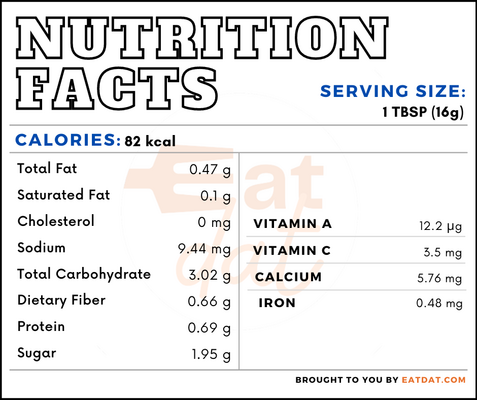
Tomato Paste
also known as Tomato Concentrate
What is Tomato Paste?
Tomato paste is a concentrated, thick paste made from cooked tomatoes.
- It has an intense tomato flavor and is used to flavor different dishes.
- This paste is an important component of Mediterranean cuisine in general, and Italian cuisine in particular.
Tomato paste is made by cooking the tomatoes until the water evaporates, leaving a rich flavorful paste. Salt is added to the paste in some cuisines, while in others, sugar is the preferred flavor. Herbs and other aromatics may also be added.
The top 10 most popular tomato paste brands are:
- Cento
- Red Gold
- Muir Glen
- SMT
- 365 Organic
- Napoleon
- Amore
- Trader Gitto’s
- Hunt’s
- O Organics
Origin of tomato paste
This paste is of Italian origin. Created in Sicily, it quickly spread to other Mediterranean countries where tomatoes were popular. Originally, it was prepared at home and every household had a different recipe. The process was typically undertaken in summertime when the tomatoes were ripe, and the paste bottled for the coming winter, allowing families to have a reserve for the entire season. These days, it is mainly produced commercially, although some traditional Italian households may still produce their own.
Nutrition
Nutritional profile for tomato paste (1 tbsp):

Tomato paste is rich in calcium, phosphorous, potassium, sodium, vitamin A, carotene, and lycopene. Also, it contains iron, magnesium, selenium, vitamin C, niacin, folate, choline, vitamin E, and vitamin K.
Tomatoes contain lycopene, which helps in reducing cardiovascular diseases, osteoporosis, and mental disorders through its anti-oxidative effects. Lycopene has also shown some alleviation of menopause symptoms. It helps in increasing vision health, regulates metabolism, and reduces the risk of certain cancers. Additionally, tomatoes are rich in antioxidants and polyphenols.
Commercial production
Nowadays, tomato paste is produced commercially. To produce just 1 kg of tomato paste with a 28 percent concentration, around 5.6 kg of tomatoes are required. First, the tomatoes are sorted and washed, before starting the process. Then, they are chopped into pieces and the pulp is pre-heated at 147-167°F (65-75°C). After that, the juice, fiber, skin, and seeds are filtered out, and the remaining tomato juice is evaporated, thickening the tomatoes into a paste ready to be packaged.
Tomato paste recipes
This paste is used to intensify the flavor of tomatoes in any dish. However, it is commonly used to create sauces for dishes like pasta, as well as soups, dips, chilis, and rice dishes. Here are a few recipes:
- Tomato Pasta
- Tomato Bulgur Pilaf
- Daoud Basha
- Fassoulia bi Zeit
- Shakshuka
- Menemen
- Minestra
- Kokkinisto
- Soutzoukakia
- Poulet Chasseur
- Patatas Bravas
FDA regulations
Tomatoes fall under the 20 most frequently consumed raw vegetables. They are also classified as a raw agricultural commodity (RAC). Tomato paste falls under the tomato concentrates category, which is defined as food prepared by concentrating the liquid obtained from mature tomatoes, the liquid obtained from the residue from preparing such tomatoes for canning, and/or the liquid obtained from the residue from partial extraction of juice. The tomato concentrate is classified as tomato paste when it contains at least 24 percent tomato soluble solids.
References
Imran, Muhammad et al. “Lycopene as a Natural Antioxidant Used to Prevent Human Health Disorders.” Antioxidants (Basel, Switzerland) vol. 9,8 706. 4 Aug. 2020, doi:10.3390/antiox9080706, https://www.ncbi.nlm.nih.gov/pmc/articles/PMC7464847/
Dalbeni, Andrea et al. “Positive Effects of Tomato Paste on Vascular Function After a Fat Meal in Male Healthy Subjects.” Nutrients vol. 10,9 1310. 15 Sep. 2018, doi:10.3390/nu10091310, https://www.ncbi.nlm.nih.gov/pmc/articles/PMC6163719/
Inigo Montoya, Understanding Tomato Paste Processing, Agro Conscious, https://agroconscious.github.io/2018-09-29-Understanding-Tomato-Paste-Processing/
